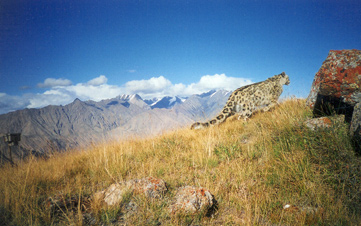Can snow leopards be saved?
Can snow leopards be saved?
mongabay.com
March 6, 2008
|
|
Conservationists and officials from twelve Asian countries are meeting in Beijing next week to discuss the fate of the endangered snow leopard. Less than 7,000 snow leopard remain in the wild.
The 2008 International Snow Leopard Conference, hosted by the Chinese Institute of Zoology in partnership with Panthera Foundation, will bring together for the first time representatives from all snow leopard range nations: China, Afghanistan, Bhutan, India, Kazakhstan, the Kyrgyz Republic, Mongolia, Nepal, Pakistan, Russia, Tajikistan, and Uzbekistan. Panthera, a big cat conservation group, has agreed to “provide the funding and collaboration necessary to implement a sweeping conservation plan for the cats,” according to a statement from the Wildlife Conservation Society (WCS), one of the sponsors of the conference.
 Seeing a wild snow leopard is such a rare occurrence that the cat is sometimes called “Ghost of the Himalayas.” But this snow leopard tripped a camera trap as it climbed up into the Tien Shan Mountains of the Kyrgz Republic. An international conference is being held on March 9-11 in Beijing, China to determine how to best protect this endangered species across its range in 12 central Asian countries. (Photo ©Kyle McCarthy, courtesy Snow Leopard Trust) |
“With this conference, we commit to undertaking an unprecedented range-wide effort to conserve the snow leopard in partnership with range-state governments, non-governmental organizations, and our other partners,” Panthera Executive Chairman Thomas Kaplan said.
According to WCS, snow leopards are threatened by poaching for their pelts and body parts, loss of habitat, increased conflict with humans and livestock, and dwindling populations of their prey.
The Snow Leopard Trust and the Snow Leopard Network are also sponsors of the conference.
Related
An interview with biologist Luke Hunter: How to save the world’s big cats
May 21, 2007 Big cats are some of Earth’s largest and most threatened predators. Long persecuted as perceived threats to livestock and humans, hunted for their skins and purported medicinal values, and losing critical habitat to deforestation and conversion for agriculture, big cat populations have dwindled around the world for the past century. Recent years have seen the extinction of two sub-species of Indonesian tiger, the Caspian Tiger from western Central Asia, a sub-species of clouded leopard from Taiwan, and the Barbary lion from the wild in North Africa. Meanwhile, populations of the Iberian lynx, Asiatic cheetah and Amur leopard have fallen so low that they would be functionally extinct without current conservation efforts. Tiger populations have declined from more than 100,000 at the turn of the century to less than 6,000 today, while cheetah number are estimated at less than 15,000. Even lion populations have dropped: from over 100,000 one hundred years ago to probably less than 40,000 today.